
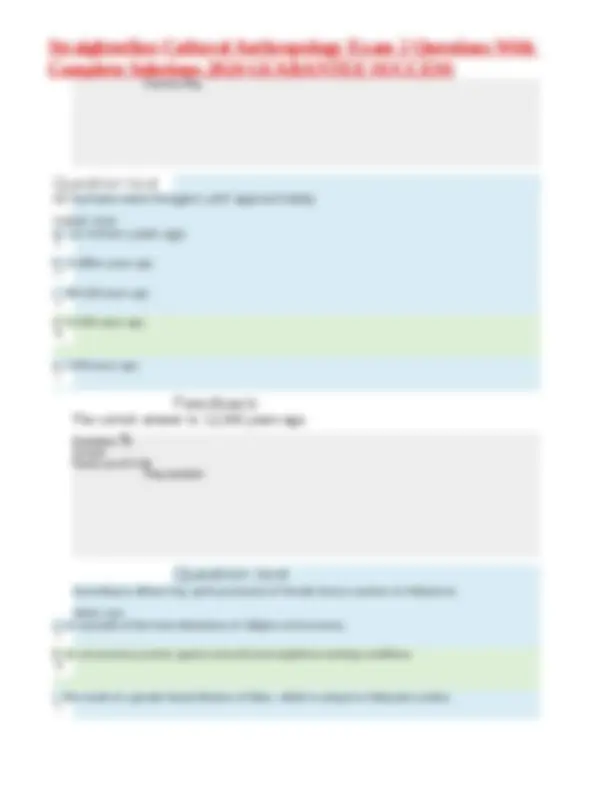
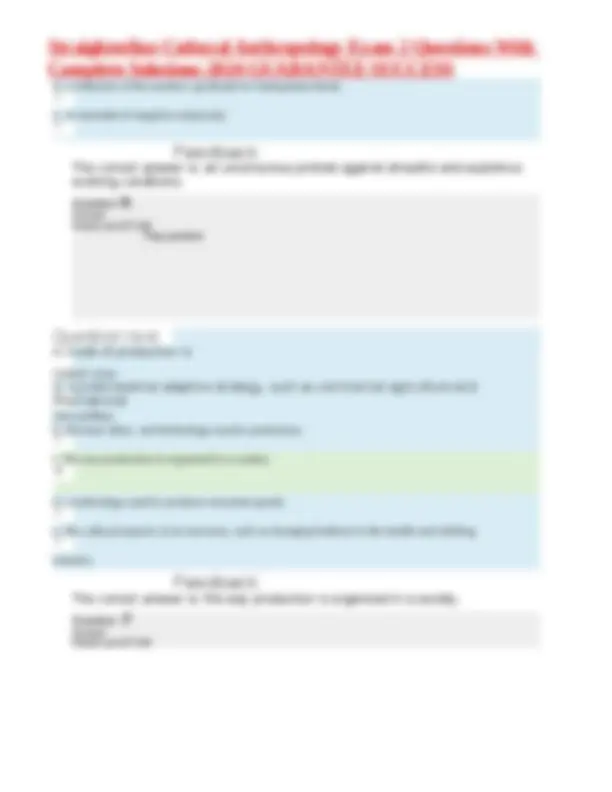
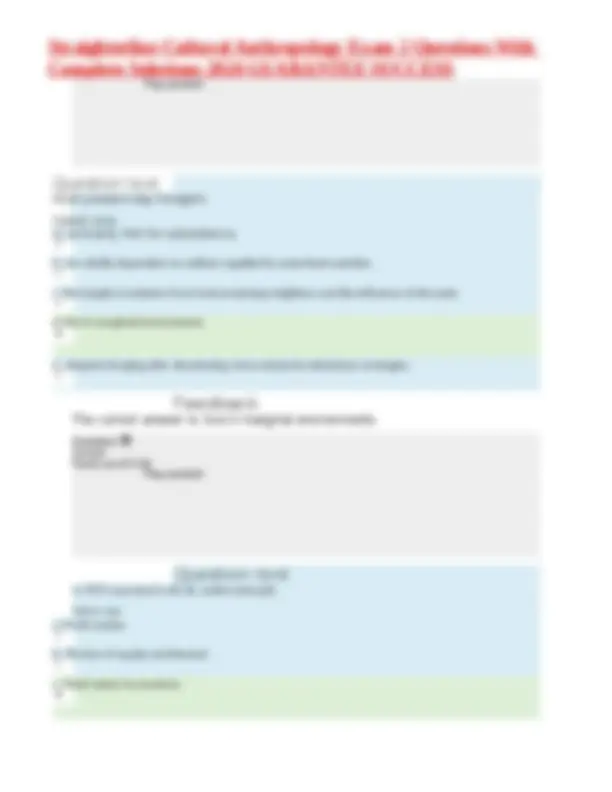
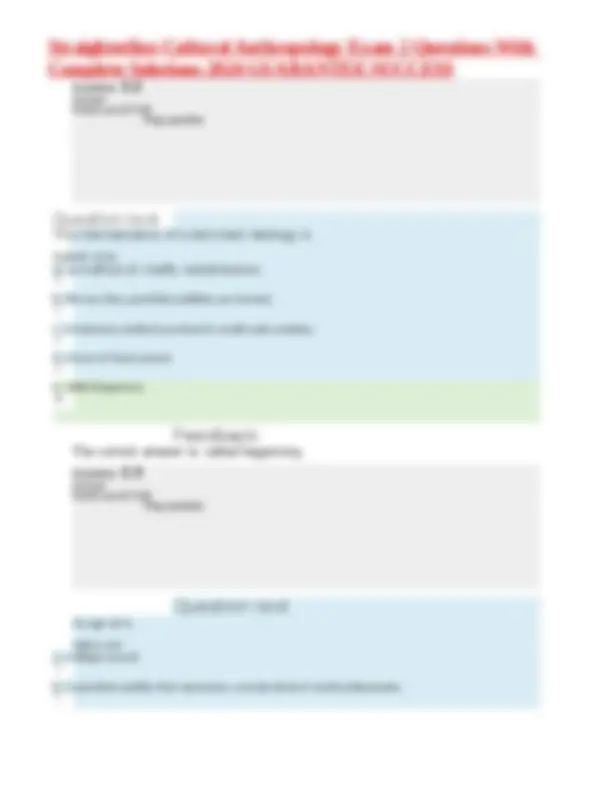
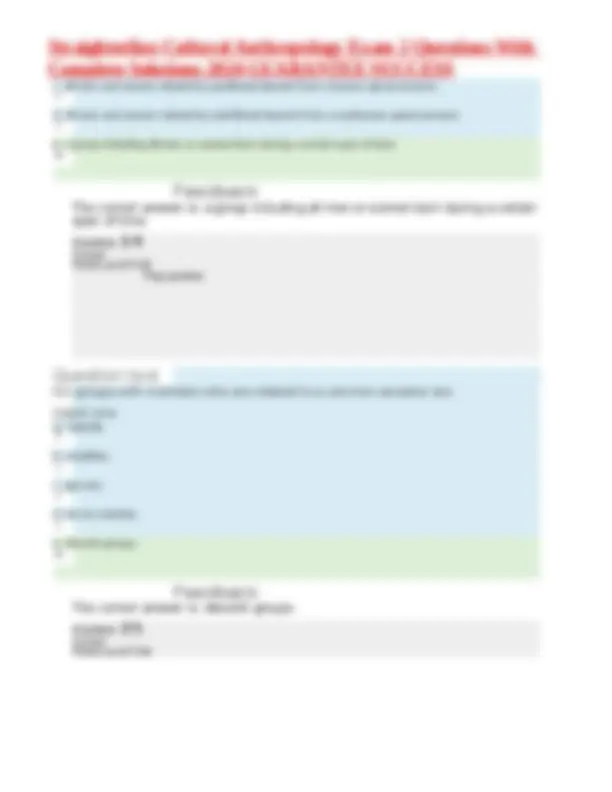
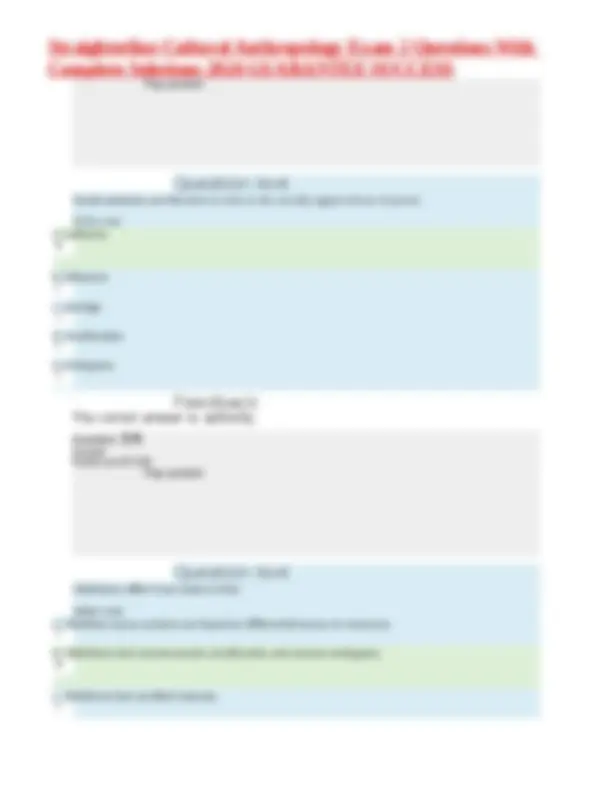
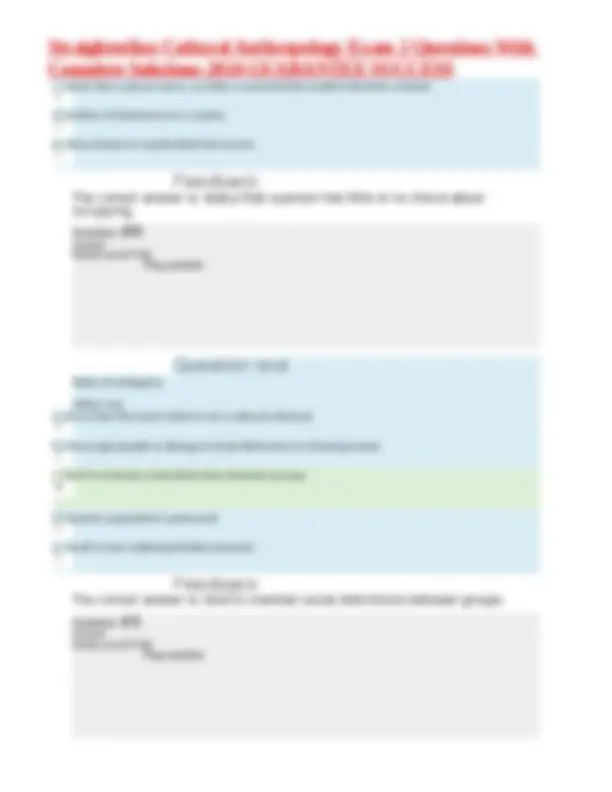

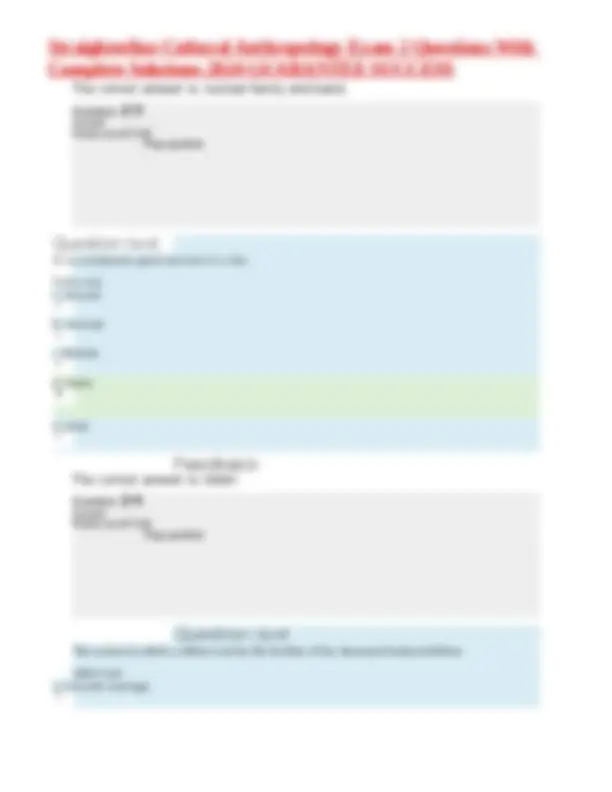


Study with the several resources on Docsity

Earn points by helping other students or get them with a premium plan


Prepare for your exams
Study with the several resources on Docsity

Earn points to download
Earn points by helping other students or get them with a premium plan
Community
Ask the community for help and clear up your study doubts
Discover the best universities in your country according to Docsity users
Free resources
Download our free guides on studying techniques, anxiety management strategies, and thesis advice from Docsity tutors
A comprehensive set of questions and answers for the cultural anthropology exam 2, covering topics such as reciprocity, modes of production, gender-based division of labor, and more. It guarantees success for students preparing for the exam. The questions cover a wide range of topics, including egalitarianism, age sets, descent groups, and endogamy.
Typology: Exams
1 / 16

This page cannot be seen from the preview
Don't miss anything!










Correct Points out of 5. Flag question e. they thought he was a vampire. land. d. they were afraid that if he took pictures of them, it would capture their souls. c. they were afraid that he was working with the national government to take away their b. he was traveling with his wife, and no one would talk to a woman.
When Kottak began researching among the Betsileo in Madagascar, the children ran away from him because Select one: a. he was associated with the schoolteachers, whom no one trusted.
Correct Points out of 5. Flag question
Cultural Anthropology Exam 2
The correct answer is: they thought he was a vampire.
When an individual gives something to someone else but expects nothing in return, this is an example of Select one:
Correct Points out of 5. Flag question e. transhumance. d. symbiosis. c. fallowing. b. swiddening.
Obligatory interaction between groups or organisms that is beneficial to each is Select one: a. cultivation.
Correct Points out of 5.
The correct answer is: generalized reciprocity.
The correct answer is: symbiosis. e. generalized reciprocity. d. specialized reciprocity. c. negative reciprocity. b. positive reciprocity. a. balanced reciprocity.
Correct Points out of 5. Flag question industry. e. the cultural aspects of an economy, such as changing fashions in the textile and clothing d. a technology used to produce consumer goods. c. the way production is organized in a society. mercantilism. b. the land, labor, and technology used in production.
A mode of production is Select one: a. a postindustrial adaptive strategy, such as commercial agriculture and international
Correct Points out of 5.
The correct answer is: an unconscious protest against stressful and exploitive working conditions.
The correct answer is: the way production is organized in a society. e. an example of negative reciprocity. d. a reflection of the workers' gratitude for having been hired.
e. adopted foraging after abandoning more advanced subsistence strategies. d. live in marginal environments. c. live largely in isolation from food-producing neighbors and the influence of the state. b. are wholly dependent on welfare supplied by state-level societies.
Most present-day foragers Select one: a. primarily fish for subsistence.
Correct Points out of 5. Flag question
The correct answer is: live in marginal environments.
c. Fixed values for products b. The law of supply and demand a. Profit motive is NOT associated with the market principle. Select one: Flag question
Correct Points out of 5. Flag question e. rent fund. d. replacement fund. c. ceremonial fund. b. subsistence fund.
When a tenant farmer gives 20 percent of his crop to his landlord, he is allocating resources to a Select one: a. social fund.
The correct answer is: Egalitarianism
The correct answer is: rent fund. e. Large population d. Irrigation c. Egalitarianism b. Sedentism is a characteristic of most foraging societies. Select one: a. Social stratification
e. called hegemony. d. a form of fiscal control. c. a resistance method practiced in small-scale societies. b. the way that pantribal sodalities are formed.
The internalization of a dominant ideology is Select one: a. a method of chiefly redistribution.
Correct Points out of 5. Flag question
The correct answer is: called hegemony.
b. a pantribal sodality that represents a certain level of social achievement. a. a village council. An age set is Select one:
Correct Points out of 5. Flag question
Correct Points out of 5. Flag question
The correct answer is: authority
e. endogamy d. stratification c. prestige b. influence a. authority Social scientists use the term to refer to the socially approved use of power. Select one: c. chiefdoms lack ascribed statuses. b. chiefdoms lack socioeconomic stratification and stratum endogamy. a. chiefdom status systems are based on differential access to resources. Chiefdoms differ from states in that Select one: Flag question
Correct Points out of 5. Flag question e. were two of the age sets in Melanesian society. structure than the Basseri. d. differ in authority structure, with the Qashqai featuring a more complex and hierarchical whereas the Qashqai village head could only lead by example. and the Qashqai, who were horticulturalists. c. differ in leadership because a Basseri "big man" (tonowi) could enforce his decisions, b. enjoyed a symbiotic relationship—between the Basseri, who were nomadic pastoralists,
The Basseri and the Qashqai Select one: a. were nomadic foraging groups in Iran.
Correct Points out of 5.
The correct answer is: chiefdoms lack socioeconomic stratification and stratum endogamy.
The correct answer is: differ in authority structure, with the Qashqai featuring a more complex and hierarchical structure than the Basseri. e. chiefdoms have full-time religious specialists. d. chiefdoms have permanent political regulation.
Correct Points out of 5. Flag question
Correct Points out of 5. Flag question
The correct answer is: status that a person has little or no choice about occupying.
The correct answer is: tend to maintain social distinctions between groups. e. status based on standardized test scores. d. position of dominance in a society. c. status that a person earns, as when a successful law student becomes a lawyer. e. result in ever-widening kinship networks. d. expand a population's gene pool. c. tend to maintain social distinctions between groups. b. encourage people to disregard social distinctions in choosing mates. a. prove that the incest taboo is not a cultural universal. Rules of endogamy Select one:
Correct Points out of 5. Flag question e. band and extended family. d. nuclear family and band. c. extended family and clan. b. lineage and nuclear family.
The basic social units typically found in foraging societies are Select one: a. band and clan.
The correct answer is: kitchen.
e. living room. d. bedroom. c. garden or yard. b. kitchen. a. family room. The Life at Home study based on middle-class families who either owned or were buying homes found that American life centered on the Select one:
Correct Points out of 5. Flag question e. postmarital residence tends to be patrilocal. d. descent groups include only the children of the group's men. c. descent groups include only the children of the group's women. father's group. father's group. b. sons become lifetime members of their mother's group, but daughters belong to their
In matrilineal societies Select one: a. daughters become lifetime members of their mother's group, but sons belong to their
The correct answer is: levirate marriage.
The correct answer is: descent groups include only the children of the group's women. e. polygynous marriage. d. levirate marriage. c. filial marriage. b. serial polyandry.